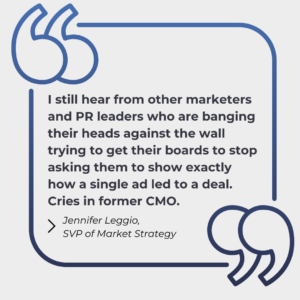Long before joining W2 Communications, I’ve been a very vocal advocate about the importance of brand awareness and public relations for driving revenue. Early last year, I spoke pretty boldly on the Breaking Through in Cybersecurity Marketing podcast about the shortsighted decisions companies were making to cut back on brand and public relations as they hit demand creation headwinds–because that is exactly how buyers are learning about companies today. At CyberMarketingCon last year, Tom Wentworth hit it home by talking about how, “Brand awareness is the REAL demand generation.” I echoed that quote almost everywhere I could. I even wrote about this topic again recently on LinkedIn.
The days of myopically dying over the pit of lead origin like Narcissus and his pool are long over.
Shockingly, despite me and other pretty seasoned in-house marketing leaders continually talking about this challenge, requirements to very quantitatively tie brand, public relations and earned digital to the lead lifecycle continued to grow. In the words of Mugatu from Zoolander, I thought I was “taking crazy pills.” This is, very simply, respectfully, wrong.
I’m pretty happy with how I’ve seen our clients operating at W2 Communications. Whether they are PR or digital or content or an integrated mix, they seem to get it. I still hear from other marketers and PR leaders who are banging their heads against the wall trying to get their boards to stop asking them to show exactly how a single ad led to a deal. Cries in former CMO.

This thinking can damage your business. You won’t always know where a lead comes from, and that’s okay if you’re attracting and converting qualified opportunities – sales team performance matters more here than content alone.
Why are companies still fixated on quantifiable lead data that doesn’t represent the full customer journey? It’s a misconception that money spent on brand awareness or content not tracked in your CRM is “wasted” or doesn’t impact sales.
Since 2022, inbound marketing has become crucial. Buyers now exist in private communities discussing tools, problems, and solutions. Yet many businesses stick to outdated pre-COVID models. Why? There’s no good reason.
Influencing these conversations requires a mix of public relations, podcasts, video, earned and paid digital content, syndication, and influencer relations. Not all of it can be measured directly against conversion metrics—and it doesn’t need to be. Trends in engagement, like website visits or social media followers, might emerge when programs run, but results often come later.
Consider PR as an example. You get a great writeup. Instead of merely posting it to social media or sending an email, treat it as a sales tool. Tailor the content to influencers and decision-makers. Use it in email sequences or drip campaigns, and ensure your sales team is leveraging it in conversations.
This is why brand awareness data is tricky. Many assets don’t show immediate results in your CRM, and even if tracked, you can’t always link them directly to conversion. Focus on goals, not just metrics, and then you’ll stop leaving revenue on the table. That’s exactly what we’re helping our clients here do.
I’m representing W2 Communications on a panel at CyberMarketingCon with Charles Gold, Cameron (Cami) Ragano and the aforementioned Tom Wentworth on “Why Marketing Leaders Succeed or Fail” and I guarantee this topic will come up. Details here: https://www.cybermarketingconference.com/




